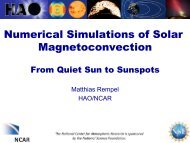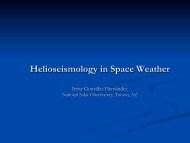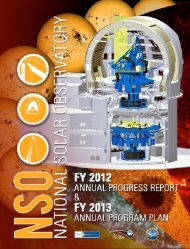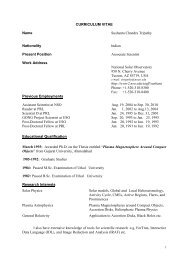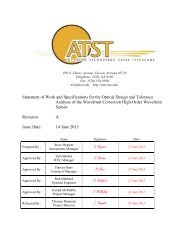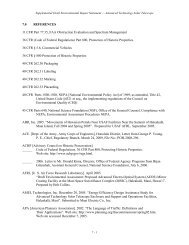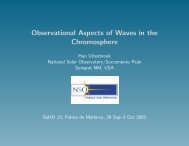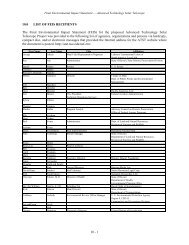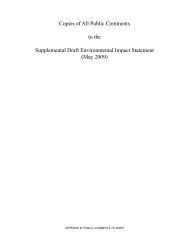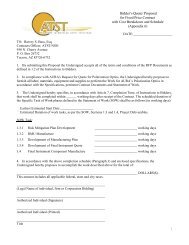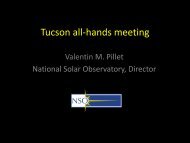F2 - ATST
F2 - ATST
F2 - ATST
You also want an ePaper? Increase the reach of your titles
YUMPU automatically turns print PDFs into web optimized ePapers that Google loves.
Cultural Surveys Hawai‘i Job Code: HALEA 2Traditional and Historic Backgroundtremendous velocity. Not having an instrument, we were unable to acertain theheight of the mountain. We presume it would not fall short of 10,000 feet. (This, Ibelieve, is the height at which it has been generally estimated) The circumferenceof the great crater, we judged to be no less than fifteen miles. We were anxious toremain longer, that we might descend into the crater, to examine the appearance ofthings below, and ascend other eminences; but as we were nearly out of provisions,and our work but just commenced, we finished our chicken and tea, and began ourdescent.3.3.2 The U.S. Navy Exploration of Haleakalā by Cmdr. Charles Wilkes (1841)On February 15, 1841, a contingent from the U.S. Navy Exploring Expedition sailed fromHilo, Hawai‘i to the island of Maui. Naturalist Charles Pickering, artist Joseph Drayton andbotanist William D. Brackenridge had been sent to Lahaina to organize an expedition to climb“Mauna Haleakalā ”. In Lahaina, the expedition was joined by the Reverend Lorrin Andrews, hisson, four students from the Men’s Seminary at Lahainaluna, and six kanakas [native bearers] tocarry food. (Andrews had made the ascent thirteen years earlier) Traveling by way of Waikapū,they were joined by Reverend Edward Bailey, headmaster of the Wailuku Female Seminary.They spent the first night at the home of Lane and Minor, “two Bostonians”, at a sugar plantationin Makawao (Wilkes 1852:167).The next day, as the expedition gained altitude, they noted the changing forest features:The face of Mauna Haleakalā is somewhat like that of Mauna Kea; it is destitute oftrees to the height of about two thousand feet; then succeeds a belt of forest, to theheight of six thousand feet, and again, the summit, which is cleft by a deep gorge,is bare.Our party found many interesting plants as they ascended Mauna Haleakalā, amongwhich were two species of Pelargonium [geranium], one with dark crimson, theother with lilac flowers; the Argyroziphium [Argyroxiphium sandwicense, subs.Macrocephalum, or Haleakalā silversword] began to disappear as they ascended,and its place was taken up by the silky species [Artemisia mauiensis, or ‘āhinahina]which is only found at high altitudes. Near the summit they found shrubby plants,consisting of Epacris [pūkiawe], Vaccinium [‘ōhelo], Edwardsia [māmane],Compositae [Dubautia plantagenia or na‘ena‘e], and various rubiaceous plants(Wilkes 1852:170).Having left the tree-line behind at 6,500 feet, the barren summit was attained and the windswere noted to have been driving with great velocity. The interior of the crater, as first viewed bythe expedition, was completely concealed by clouds. The elevation reading by barometer wasinterpreted as 10,200 feet. Barometric readings were continued as the expedition descended intothe crater:The crater of Haleakalā , if so it may be called, is a deep gorge, open at the northand east, forming a kind of elbow; the bottom of it, as ascertained by the barometer,was two thousand seven hundred and eighty-three feet below the summit peak, andtwo thousand and ninety-three feet below the wall. Although its sides are steep, yeta descent is practicable at almost any part of it. The inside of the crater was entirelyAPPENDIX F (2): Supplemental Cultural Impact Assessment For the Proposed Advanced 27Technology Solar Telescope (<strong>ATST</strong>) at Haleakalā High Altitude ObservatoriesTMK (2) 2-2-07:008



